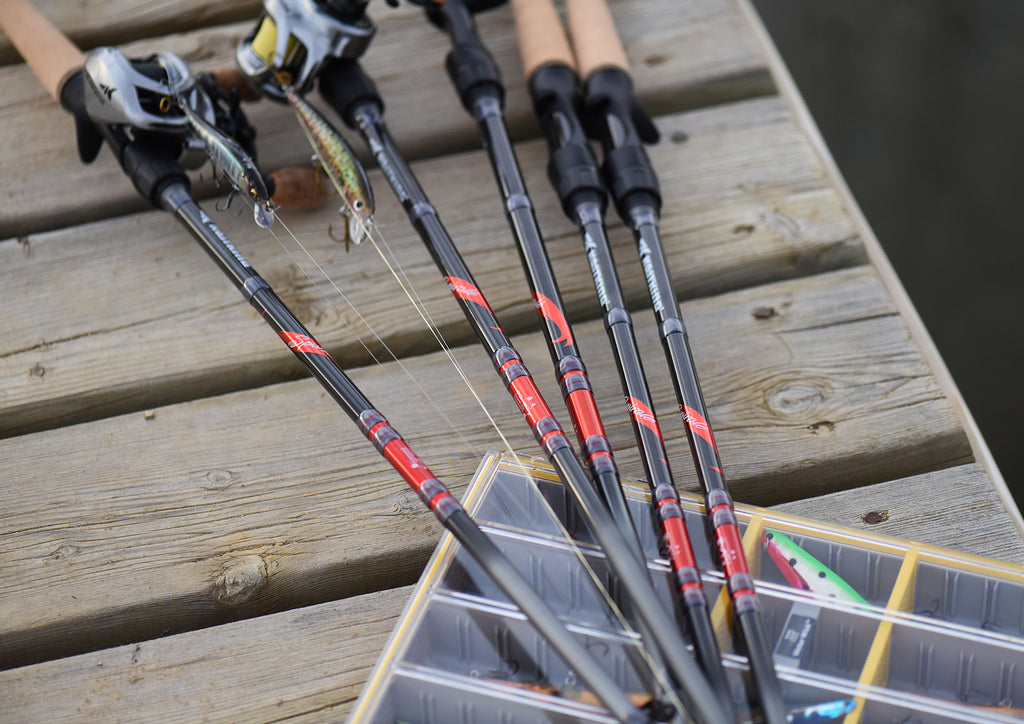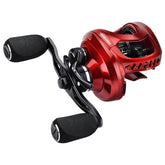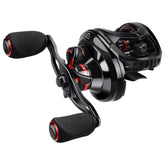
When to Use a Spinning Rod VS Baitcasting Rod
Do you own both baitcasting and spinning rods? Do you ever battle with which rod should be used and when? Baitcasting (conventional), and spinning rods crossover in many areas, but there are certain times when a baitcaster will out-perform a spinning rod, and on the other side, a spinning rod will out-perform a baitcasting rod. They are similar, but totally different…let’s take a look and make sure you are getting optimum performance out of your gear. When to use a spinning rod vs a baitcasting rod is not that difficult.
What Can They Do?
For the most part, the biggest difference between the two in my opinion, is that a baitcasting rod for the most part is built for power, whereas the spinning rod is built for distance.
Baitcasting rods will usually have a lot more guides than spinning rods. This helps get the total power out of the rod by utilizing the entire rods length without skipping over wide sections. If you look at most baitcasting rods, they have 8 to 12 guides, depending on the length. The guides are also low profile as the line coming off the reel is straight and not spinning outward like in a spinning reel.
As you can see, the first guide on a baitcasting rod is much smaller than a spinning rod guide. The revolving spool and line flowing straight off a baitcasting reel and the coiling of line coming off a spinning reel is the reason for the difference in guide size.

When you look at spinning rods, the guides are spread out along the blank, and of a higher profile and diameter. The higher profile and larger guide ring helps capture line as it comes off a spinning reel in larger loops. This aids in casting distance, and helps eliminate wind loops.
Unless you are a really adept caster and very good with both spinning and baitcasting rods, longer casts will be made from a spinning rod. On the other hand, more accurate and a powerful hookset and “fight” of the fish will be achieved with baitcasters.
Specific Uses
Beginning with baitcasters, let’s take a look at where they will be better suited than a spinning rod. Before we get into when and why, a baitcaster or conventional style rod are basically the same animal. They both offer guides above the blank, and both offer smaller guides.
A baitcaster will allow the angler to pinpoint casts under trees, into docks and other areas easily. They will allow an angler to put optimum pressure on a fish when setting the hook in heavy cover. Another area where these rods excel is deep water angling where 8 to 10 ounces of lead are used or in the trolling game where heavier lines or even wire will put extreme pressure on the rod.
When I jig a beaver dam for largemouths I need a stout baitcaster for accuracy of the pitch, and the ability to pull a big fish out of the wood.

Although some believe a baitcaster will outcast a spinning rod, I believe even though the line comes straight off of a baitcast reel, and through the guides with virtually no friction, unless you are a highly skilled angler, the distance you cast will be less than a spinning rod.
- Pinpoint casting
- Heavy cover
- Deep water/heavy sinkers or lures
- Topwater cadence
Moving to the spinning rod, the largest advantage is the ease of casting for beginners and skilled anglers. The reels used are simple to operate, and making long casts are easily obtained when needed. A spinning rod has larger guides which allow the line coming off the reel to slide through easily.
Casting large popping plugs like this 2-ounce Super Strike requires spinning gear for long casts.

A spinning rod is best suited for lighter lines and baits when used in the freshwater venue, but when hitting the saltwater side, they are the optimum rod for surf casting and pier fishing. The spinning rod, which will range from shorter 4 foot trout and panfish models up to heavy 12 foot models for surf fishing, with all weights and tapers as well.
- Distance
- Ease of use
- Larger range of sizes
- Lighter lines
Time to Choose
Whether you decide to use a baitcasting rod or a spinning rod, just like in choosing the “correct” reel, you need to explore what type of fish, where you are fishing – deep saltwater, light freshwater, heavy cover, etc. – before you choose which way to go.
If you are a beginner to fishing, especially when it comes to mastering casting techniques, the spinning rod is probably the better choice. A spinning rod is a lot more forgiving in the learning curve where 'casting for beginners' comes into play. On the other hand, if you are an adept angler, you need to explore what you will be doing. Do you plan on surf casting for black drum or striped bass? If so, then a heavier 10-11 foot spinning rod is a good choice. Are you throwing Texas rigged worms in heavy cover for largemouth bass? A baitcaster will give you the power to winch the bait, and subsequent fish, through the slop. How about when light fishing line in the 2-6 pound class and light 1/32 or smaller lures are used? In such cases, using a spinning rod for these delicate casting scenarios is a piece of cake.
There are situations where one or the other will be best suited, but it really is up to you, the angler, to decide what option will work best.












